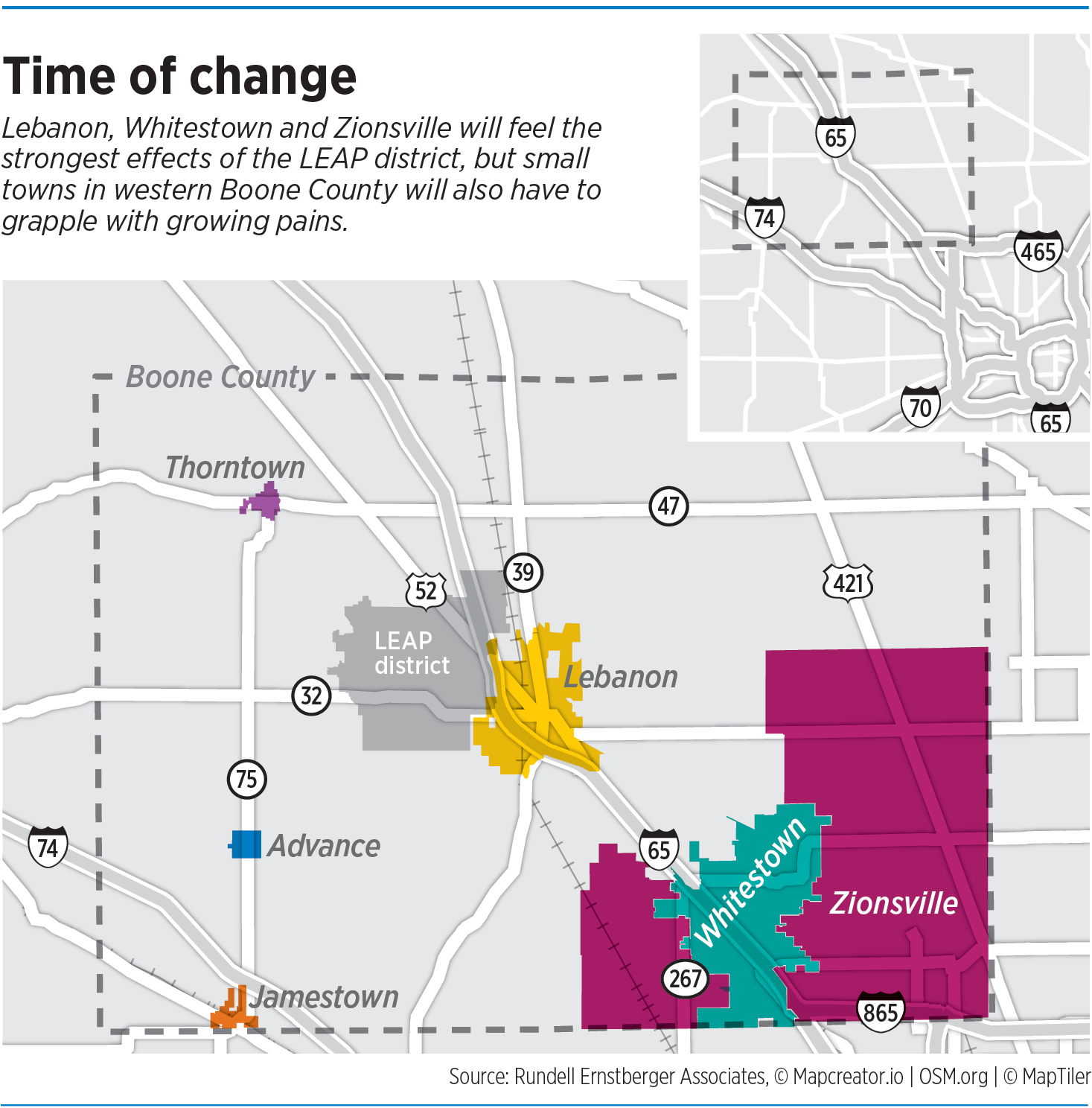Subscriber Benefit
As a subscriber you can listen to articles at work, in the car, or while you work out. Subscribe NowBoone County is growing, but the big questions are whether it’s ready for that growth and how its communities need to prepare for the LEAP Research and Innovation District.
To find answers, the Boone County Economic Development Corp. commissioned a housing study and utility-needs analysis about a year ago.
Boone EDC Executive Director Molly Whitehead said she asked the consultants—Philadelphia-based Urban Partners and Indianapolis-based HWC Engineering—to forecast the county’s population over the next quarter century and detail the housing impact.
“Do we have something to fit everybody’s lifestyle? If not, what do we need to focus in on? And then what are those potential barriers? Is it land? Is it infrastructure costs?” Whitehead said.
While the full report is not yet complete, the Boone EDC released a presentation last month that presented the major findings that explain some of the challenges county and community leaders will need to address in coming years.
For one, Boone County’s population will continue to increase. In 2000, the county had about 46,000 residents. In 2025, the population is projected to surpass 77,000.
The projected population without the LEAP district in 2050 is around 97,000. If the LEAP district is developed as planned, the county could have 135,000 residents by mid-century, according to the study.
“[The year] 2050 may seem like a long way off, but honestly it’s not,” Whitestown Town Council President Dan Patterson said. “You can’t take a two-year or a five-year view. You have to look out 10, 20, 30 years to really try to anticipate the future needs and how you can get to that point to make sure you do it as efficiently and economically as possible.”
Another challenge is the cost of housing. Boone County has the second-highest average household income in central Indiana, at $94,843. Only Hamilton County’s is higher, at $104,858.
While high-earners can afford to live in Boone County, housing is becoming less attainable for people who work in its schools, warehouses, restaurants and public safety departments.

“As a county, I think all of the communities kind of need to come together, because it is getting very expensive to live here very quickly,” said Stephen Elkins, executive director of Boone County Area Plan Commission. “While it may not impact people so much now, when the next generation comes in and wants to buy housing, they’re likely going to be priced out. It’s just a conversation I hope this housing study leads to.”
The presentation noted that newly built houses are getting larger, exacerbating the challenges of housing affordability. From 2018 to 2022, single-family house prices increased 51% in Lebanon, 38% in Zionsville, 33% in Whitestown and 27% throughout the rest of the county.
Additionally, monthly rents for one-bedroom apartments now range from $820 to $1,449 in Lebanon, $717 to $2,316 in Whitestown and $1,195 to $1,999 in Zionsville.
The presentation said 28.8% of Boone County households are cost-burdened.
“Things are great here. We’re a fast-growing community,” Whitehead said. “We shouldn’t have much to complain about. But there’s some people out there that could use some help, and we need to figure out what the potential solutions are.”
The Indiana Economic Development Corp. purchased nearly 9,000 acres north and west of Lebanon in its push to create the LEAP district. Since July 2022, Lebanon has annexed nearly 8,000 acres of unincorporated land for the innovation district.
Indianapolis-based Eli Lilly and Co. broke ground last year on a $3.7 billion manufacturing campus in the LEAP district that is expected to create 700 jobs. LEAP is an acronym for “Limitless Exploration/Advanced Pace.”
While most growth will be centered around Lebanon, Whitestown and Zionsville, small towns in western Boone County—such as Thorntown, Advance and Jamestown—could experience growth of their own. Elkins said the utility and infrastructure capacities in those towns are limited.
“[Lebanon, Whitestown and Zionsville] have the utilities, and they also have the planning visions that envision more dense residential growth than in other parts of the county,” Elkins said.
Lebanon Mayor Matt Gentry said a proposal by the IEDC to transport as much as 100 million gallons of water a day through a 35-mile pipeline to Boone County from an aquifer in Tippecanoe County would benefit communities throughout the county and central Indiana region.
The controversial plan has generated protests in Tippecanoe County and has been a topic of conversation during the current Indiana General Assembly.
“Bringing additional water sources to Lebanon is something that has been talked about long before I was mayor, and this is something that my predecessors worked quite hard on, as well,” Gentry said. “We’ve known this has kind of been a looming issue for us.”
Lebanon approved more than 800 new housing units last year, including four developments on the north side of the city near the LEAP district site. Gentry also has focused on developing the city’s downtown to bring more housing, retail and restaurants to its core.
Additionally, Lebanon-based real estate consultancy 11th Street Development LLC is building two efficiency-minded neighborhoods near Lebanon Business Park. One is a row-house community with 54 for-sale lots at Patterson and Noble streets. Another is a 30-unit cottage community along Ash Street.
Gentry said the developments are examples of how Lebanon is trying to be creative and flexible about what types of housing are available.
“For a long time, people just wanted high-end housing, whereas I think today—understanding how workforce works and how life cycles work with people—having housing options available for all price points is really the key for any city to strive for,” he said.
Zionsville Mayor John Stehr said his town will need to develop a new comprehensive plan to adequately prepare for coming growth. He said Zionsville needs all types of housing and that it needs to lift some of the “barriers to entry” that prevent people from living there.
Stehr said he expects Perry Township and Zionsville’s north side to be the next growth areas. On the east side of town, a 48-acre project called The Farm at the southwest corner of North Michigan Road and Sycamore Street will include a three-building, 400-unit apartment development.
“We want to make sure that our community is working on all levels, and that our teachers and firefighters and police officers and others can all live in the community they work in,” Stehr said.
And in Whitestown, homebuilders constructed nearly 500 houses last year. An additional 2,000 have been approved to be built.
The community along Interstate 65 has grown from fewer than 500 residents in 2000 to nearly 12,000, according to the U.S. Census Bureau. Most of that growth has come in the last decade, and town officials believe Whitestown’s population will reach 25,000 in the next decade.
Whitestown Public Works Director Danny Powers said the LEAP district will put more pressure on the town to increase its housing supply and ensure that its water and sewer systems can support more people.
“Looking at the [housing] study, it’s good for Whitestown to see what is expected to come in Boone County and how it affects not only us but all of our neighbors, and so it’s just, how can Whitestown continue to prepare for the growth that we will be experiencing?” Powers said.
Rural expectations
Officials in Thorntown, a community of about 1,400 in northwestern Boone County, also expect the town to experience change from the LEAP district. The town’s location west of Interstate 65 and U.S. 52 and along State Road 47 could make it a prime location for growth.
The town is also near spots where Boone County is considering a zoning overlay district to steer growth in unincorporated rural areas.
Last year, Thorntown approved a subdivision on its west side that will add 163 houses to its supply. Elkins said Thorntown’s water and sewer systems can’t support more new homes than what’s planned for that subdivision.
Thorntown Clerk-Treasurer Koren Gray said the town needs to grow but that the idea is unnerving to some residents. In recent years, the town has added municipal employees and formed an advisory planning commission.
“It’s sometimes a little scary because it just brings in so many people, but I also know that if we don’t have change, if we don’t bring in people … we’re not going to have amenities here,” Gray said. “I really feel like we’re at a point that we have to have some growth in order to survive.”
Similarly, in Jamestown, officials are looking at the LEAP district as an opportunity. Jamestown Redevelopment Commission President Tina Pennington said housing is the town’s biggest concern.
She added that Fukai Toyotetsu Indiana Corp., which opened a factory in 2017 in Jamestown near Interstate 74, would like more housing so employees can live closer to work.
However, before Jamestown can grow, it will need to find an additional water source. The town has unsuccessfully searched for new wells in recent years, and it would benefit from the LEAP pipeline.
“We do know it needs to grow because if you just stay stagnant, you get swallowed up. It’s the way of the world these days,” Pennington said. “We’re making some strides there. But there’s room to grow, and there’s room to add things. … We’re for the most part excited about it [and also] a little apprehensive of all the growth and how quickly it will come.”•
Please enable JavaScript to view this content.







The answer is dense housing + multi-modal transportation. Anything less – especially in Indiana – will lead to 50 years of boom, followed by 50 years of bust.
While some of these comments are nice to hear, I also know there’s been bickering within Whitestown about funding the CITRA workforce bus that Indianapolis residents use to get to the warehouses. You’re going to pay for it one way or the other. Either by offering transit to get workers to and from, or by making housing affordable for the workers in your community.
“when the next generation comes in and wants to buy housing, they’re likely going to be priced out” – is Stephen Elkin sleeping under a rock?… This is already happening.